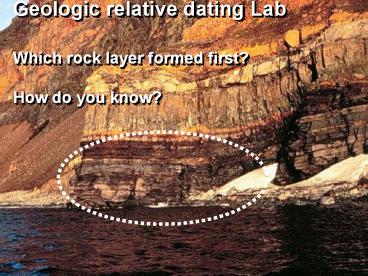Relative Dating - PowerPoint PPT Presentation
Title:
Relative Dating
Description:
Which rock layer formed first? How do you know? Relative Dating Lab Which geologic event occurred first?? Geologic relative dating Lab Relative Dating: Unraveling ... – PowerPoint PPT presentation
Number of Views:99
Avg rating:3.0/5.0
Title: Relative Dating
1
Geologic relative dating Lab
Which rock layer formed first? How do you know?
Relative Dating Lab Which geologic event
occurred first??
2
Relative Dating Unraveling earth history by
placing geologic events in chronological
order Which geologic process came first?
NO actual numbers applied!
3
- Objectives
- To observe exposures of rock and decipher
- the geologic history
- Use relative dating principles to unravel
- geologic history
Which layer was deposited first A,B,C,D, or E??
4
Lets unravel some geologic history from
observations of various formations and their
contacts
Nicholas Steno 1669 proposed the following
relative dating principles
- The principle of Original Horizontality
- Sedimentary rock layers are deposited as
horizontal strata - Any observed non-horizontal strata has been
disturbed
Sediment input
C
B
A
5
Strata has been deposited in horizontal
layers Original Horizontality
6
- The principle of Superposition
- In any undisturbed sequence of strata, the
oldest stratum is at the bottom of the
sequence and the youngest stratum is on top.
5
Youngest
4
3
2
1
Oldest
7
Which strata are older and younger??
Youngest
Oldest
8
- The principle of Inclusions
- A piece of rock (clast) that has become
included - in another rock body is older than the rock
body - it has become part of why?
Rock body A
A
A
A
Older (rock A was there first)
Intrusion of pluton B
9
Which granites are older and younger?
OLDER
YOUNGER
10
- The principle of Cross Cutting relationships
- Any geologic feature that cuts across another
geologic - feature is younger
5
Is layer 5 older or younger than the
intrusive dike ??
4
3
2
6
1
11
A
B
C
Qtz-Asp Vn
Which dikes formed first?
12
Given this sequence of rock layers, Whats
wrong with the timing of events????
A time of erosion or non-deposition missing
time
Youngest
7
6
3
2
1
Oldest
13
- The principle of Unconformities
- Rock surface that represents a period of erosion
or non deposition - Referred to missing time
- Three major types of unconformities
- Disconformity
- Angular unconformity
- Non-conformity
Disconformity uncon in non-disturbed
sedimentary layers
Angular uncon uncon lies between angled strata
and overlying horizontal
strata
Non-conformity sedimentary strata
overlies crystalline
rocks (ig and met)
Unconformity
14
Disconformity
Angular Unconformity
Sedimentary rocks
Nonconformity
Xln rocks
15
Lets apply the principles and unravel earths
history Which came first? -- start with oldest
to youngest
I
Deposition of layers G,H,I
youngest
H
G
Angular Uncon F
A
F
Tilting of layers E,D,C,B,A
B
C
D
E
Deposition of layers E,D,C,B,A
oldest
16
Rock symbols (rock legends)
Understand the various types of rock
(lithologic) symbols in conjunction to the
principles to determine the geologic history of
an area.
emplacement
deposition
17
The principle of Faunal (fossil) succession
This principle is attributed to William Smith, an
English engineer in the late 1700s. Smith noticed
that the kinds of fossils he found changed
through a vertical succession of rock layers, and
furthermore, that the same vertical changes in
fossils occurred in different places.































